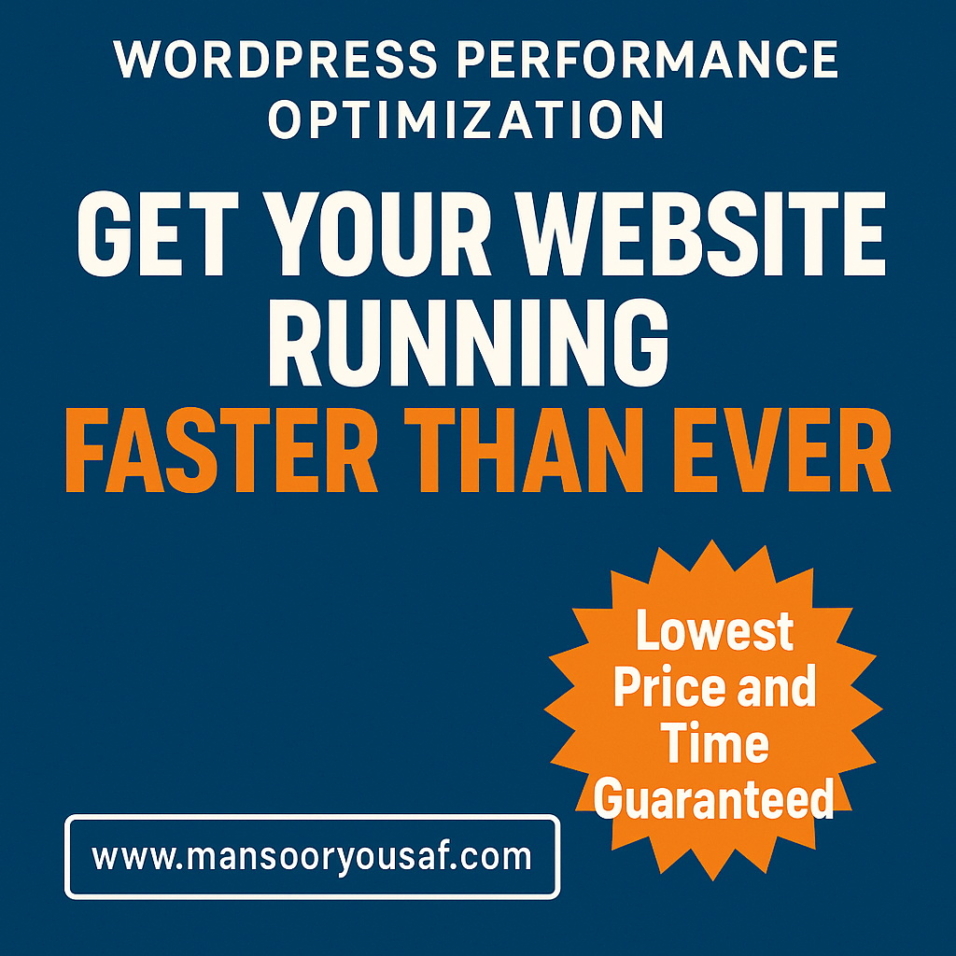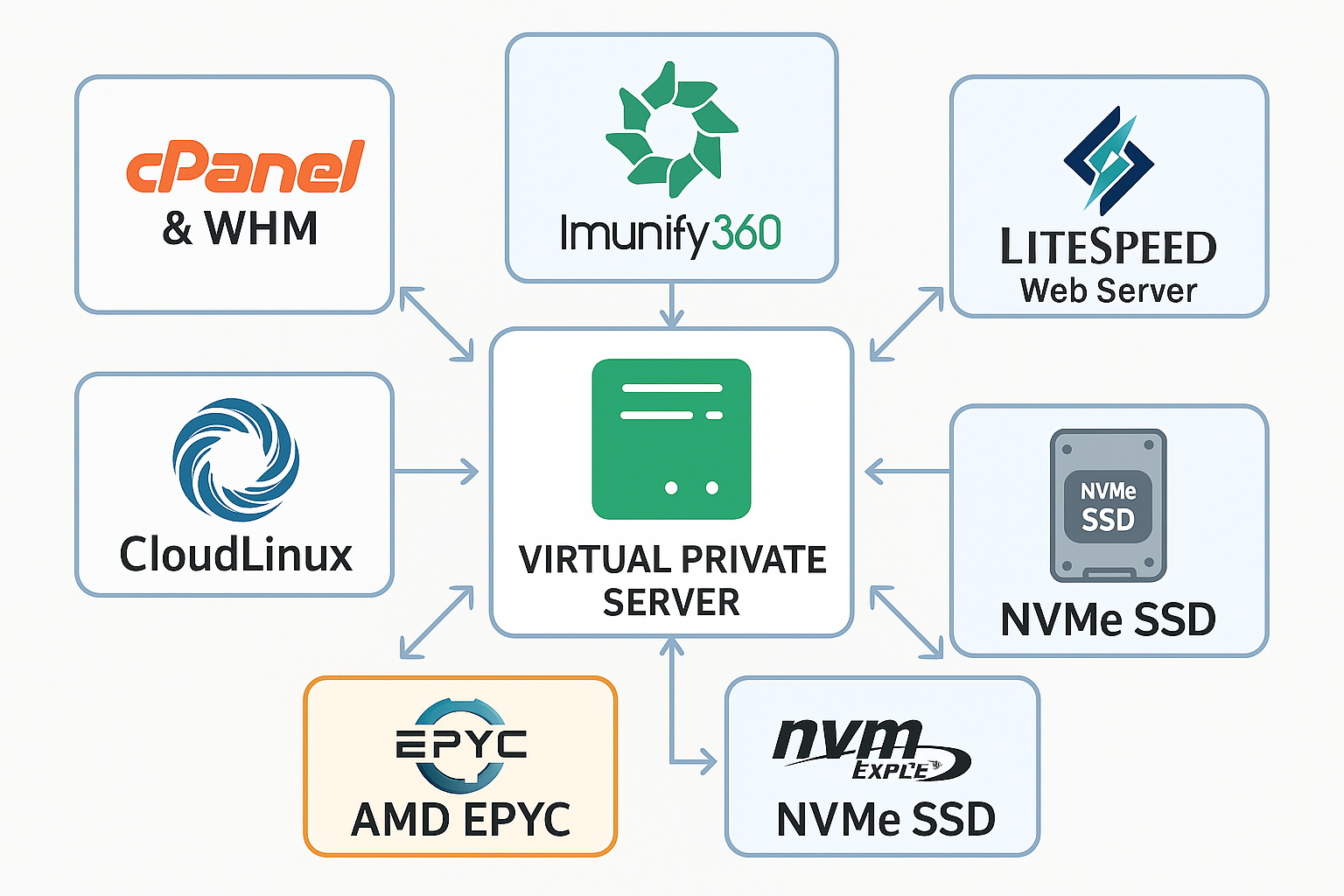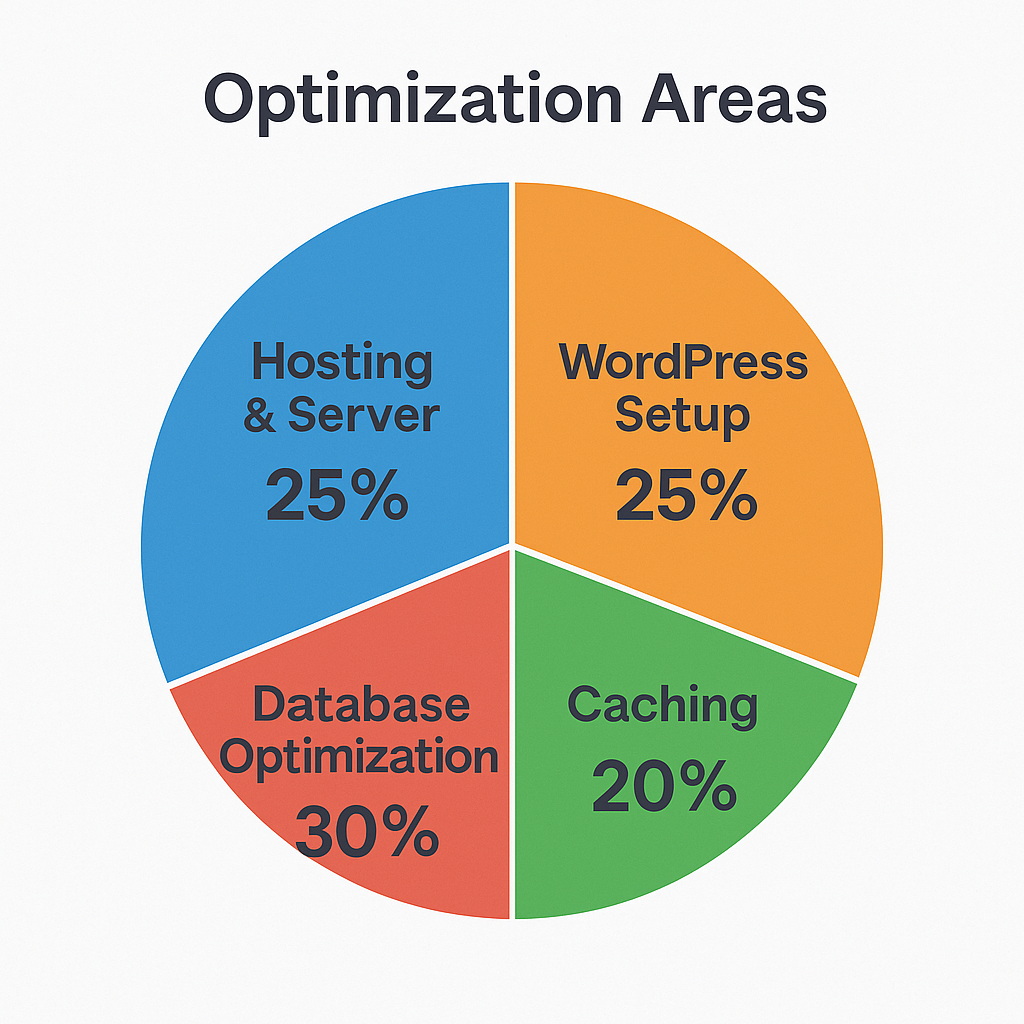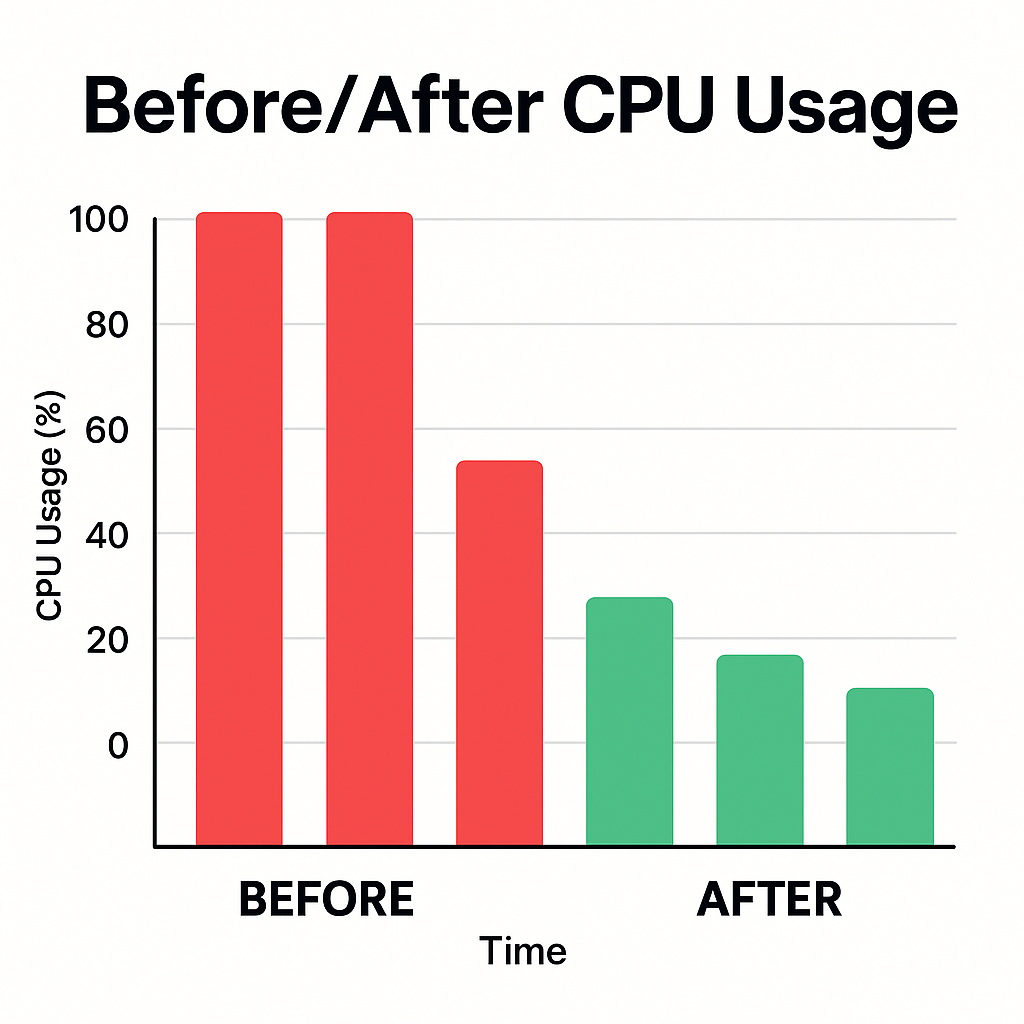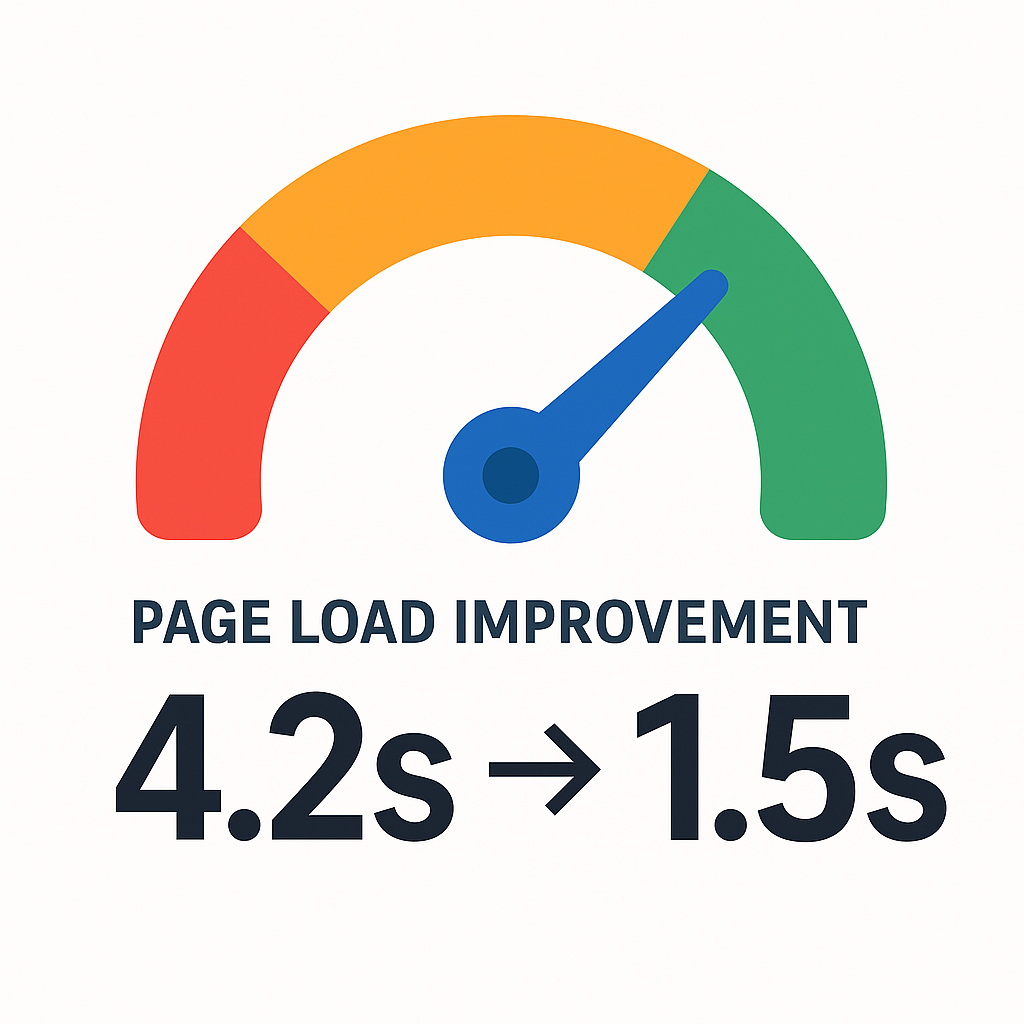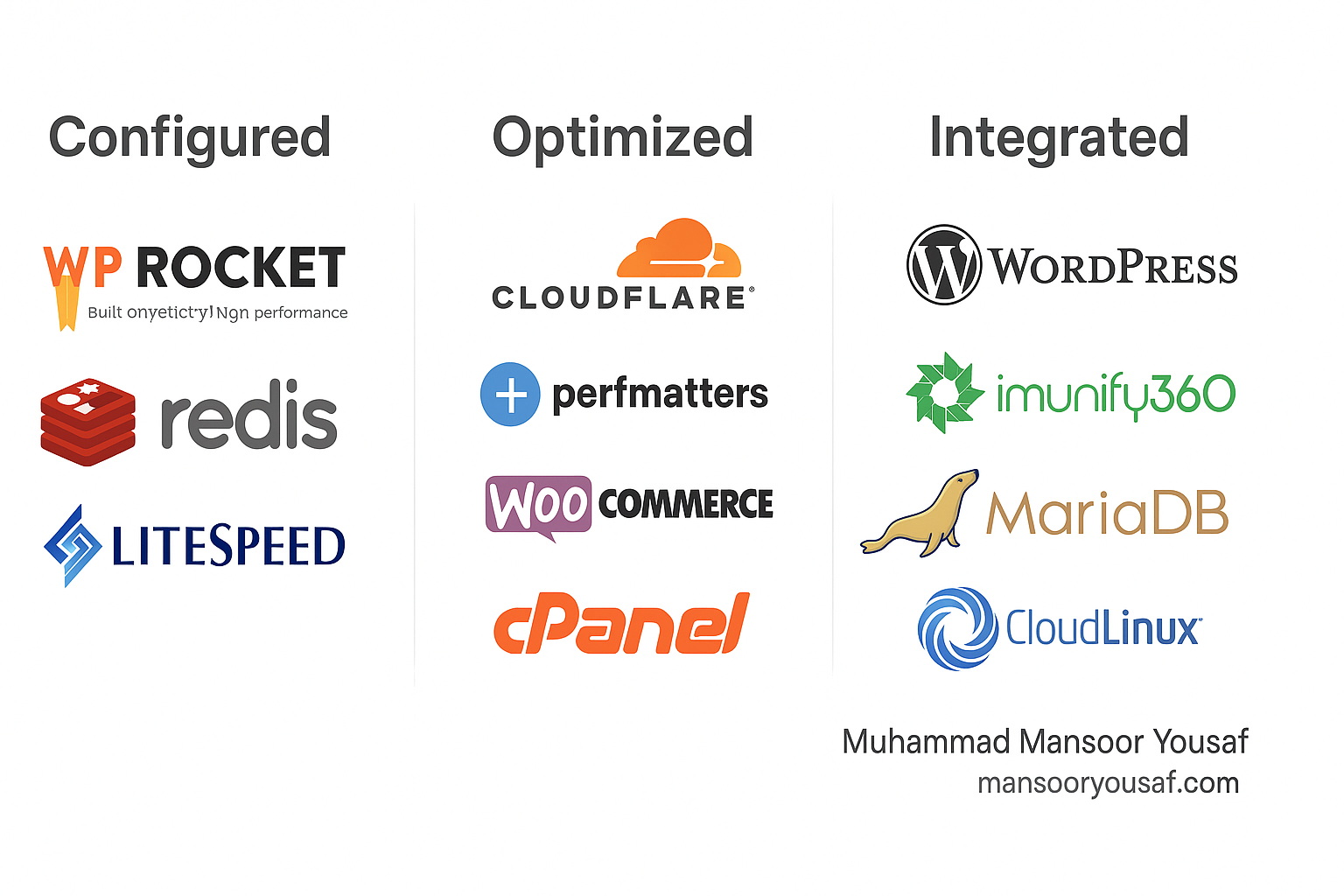Running a high-traffic WooCommerce store but struggling with high CPU usage, slow page loads, or random errors? In this in-depth case study, I show how I reduced WooCommerce CPU and memory usage, stabilized checkout, and speed up page loads using WordPress best practices—server tuning, Redis Object Cache Pro, WP Rocket, Cloudflare, and smart code-level optimizations. Whether you run a small shop or a massive eCommerce site, I can optimize your WordPress performance—guaranteed at the lowest price worldwide.
If you run a WooCommerce store, you know how frustrating it is when the site feels sluggish, checkout keeps loading, or—worse—your server collapses under peak traffic. High CPU and memory usage isn’t a minor issue; it crushes conversions, hurts SEO (Core Web Vitals), and kills customer trust.
Introduction: The Real Problems Most WooCommerce Stores Face
I’ve worked with WordPress since 2008. From boutique shops to enterprise WooCommerce, I keep seeing the same patterns:
- Slow page loads—especially product, cart, and checkout pages.
- CPU pegged at 90–100% during promotions or bot spikes.
- Memory spikes, WordPress high memory usage, or WordPress memory_limit error.
- Random HTTP 500 WordPress and 502/504 timeouts.
- WooCommerce slow admin/backend, slow add to cart, or WooCommerce checkout loading spinner.
- Occasional fatal messages: “There has been a critical error on this website. WordPress.”
I’m not sharing a “free step-by-step” because every site is unique. But I’ll show you the exact principles and actions I used to cut CPU, reduce memory, and speed up WooCommerce. If this reads like your situation, contact me—I’ll fix it permanently, and at a price no one can beat.
Case Study Setup: High-Traffic WooCommerce on a Serious Server
The store lived on a robust VPS but still struggled. Here’s the full environment:
| Specification | Details |
| CPU | 8 vCPU (AMD EPYC 7543 Processor) |
| RAM | 16 GB |
| Storage | NVMe SSD |
| OS & Control Panel | CloudLinux + cPanel/WHM (root access) |
| Web Server | LiteSpeed Web Server Professional (2 workers license) |
| Security | Imunify360 |
| Theme | Woodmart (fast loading WooCommerce theme when tuned) |
| Caching | WP Rocket (WordPress speed optimization plugin) for page cache |
| Asset Optimization | Perfmatters (minify & remove unused CSS) |
| Object Cache | Redis Object Cache Pro (Redis object cache WordPress) |
| CDN | Cloudflare (Free Plan) with intelligent cache rules |
| Database | MariaDB (tuned for WooCommerce queries) |
| Traffic | High daily traffic with heavy peaks during promos |
💡 Note: This was a test environment I optimized—but I can optimize any server setup (shared hosting, VPS, dedicated) and any plugin stack (LiteSpeed Cache, W3TC, Sucuri, etc.). Every website has different requirements; I audit your stack and tailor the solution.
Diagnosis: Why CPU & Memory Were So High
Throwing more hardware at WordPress rarely fixes the root cause. Performance is about eliminating bottlenecks. My initial audit surfaced:
| Area | Observation | Impact |
| Server Configuration | Default MariaDB config, suboptimal LSAPI workers, no caps for runaway processes | CPU thrash during concurrent requests |
| Caching Strategy | WP Rocket solid, but key endpoints not cached (cart/checkout/admin-ajax/cron) | PHP executed more often than necessary |
| Plugin Overhead | Some plugins issued redundant queries & extra AJAX | Slower category/product pages |
| Theme Behavior | Woodmart loaded extra scripts globally | Raised TTFB and total bytes |
| Database Queries | Unindexed, heavy WooCommerce queries during peak loads | Stalls under concurrency |
| Cloudflare | No granular rules for caching static HTML safely | Lost CDN offload and cache hit ratio |
Common symptoms I also see on troubled sites (and I address in audits): WordPress slow loading, WordPress slow backend, WooCommerce slow admin, WooCommerce slow checkout, WooCommerce slow queries, and frequent spikes from bots that inflate WordPress server load.
Optimization Strategy That Worked (Without Sharing Sensitive Steps)
I focus on four pillars: server, WooCommerce behavior, caching layers, and plugin/assets. Below is what I did (high level). I’ll design a custom plan for your site after a quick audit.
1) Server-Side Tuning (CloudLinux + LiteSpeed + MariaDB)
- Right-sized LiteSpeed LSAPI workers and concurrency for real traffic patterns.
- Tuned OPcache, process limits, and memory to cut forks and stabilize PHP.
- Applied smart CloudLinux LVE limits to avoid noisy-neighbor spikes and fork bombs.
- Adjusted MariaDB (optimize WordPress database) for WooCommerce transaction patterns and slow queries.
- Protected CPU by filtering resource hungry bots (Cloudflare firewall) while allowing genuine crawlers.
2) WooCommerce-Specific Adjustments
- Reduced unnecessary admin-ajax chatter on product/category templates.
- Balanced cart fragments: fewer needless refreshes = fewer PHP hits.
- Improved session & object-cache usage (Redis Object Cache WordPress) to avoid repeated DB work.
- Scaled images and used a WordPress image optimizer to optimize images WordPress-wide.
3) Smart Caching Layers (WP Rocket + Cloudflare + Redis)
- Kept WP Rocket for full-page cache; tuned rules for WooCommerce dynamic endpoints.
- Used Redis Object Cache Pro to persist hot queries and reduce DB overhead.
- Added Cloudflare cache rules to safely cache everything where possible, excluding cart/checkout/my account and logged-in users.
- Ensured compatibility with WordPress SEO optimization plugin (Yoast/Rank Math) and GA tracking.
4) Plugin & Asset Audit
- Found and throttled resource intensive plugins and scripts that caused CPU spikes.
- Used Perfmatters to conditionally load CSS/JS (speed optimization in WordPress).
- Trimmed theme bloat in Woodmart—only keep what converts.
Results After Optimization (CPU ↓, Speed ↑, Stability ↑)
| Metric | Before | After | Improvement |
| CPU Usage at Peak | 90–100% | 25–35% | ~70% lower |
| Average Page Load Time | 4.2 sec | 1.5 sec | 64% faster |
| Concurrent Visitors Handled | ~40 | 150+ | 275% increase |
| Memory Usage | ~14 GB | ~7 GB | 50% lower |
| Checkout Failures | Frequent | Zero | 100% resolved |
A before/after CPU usage graph showing the dramatic drop after optimization.
A speedometer-style graphic showing page load improvement from 4.2s → 1.5s.
Why DIY Usually Fails for WooCommerce Performance
Installing another cache plugin or upgrading your VPS often isn’t enough. Here’s why:
- Caching is just one layer. Without DB, PHP, and server tuning, you still waste CPU cycles.
- Every WooCommerce site is unique. Plugins, theme, traffic sources, and checkout flow differ.
- Random tutorials can break stores. I routinely fix sites after “quick fixes” caused WordPress 500 internal server error, 403 forbidden error WordPress, or “error establishing a database connection WordPress”.
Common WordPress/WooCommerce Errors That Hurt CPU & UX (and How I Approach Them)
| Error | What Users See | What It Typically Means | My Approach (High Level) |
| There has been a critical error on this website. WordPress | White screen / fatal | Plugin/theme conflict, PHP fatal, memory limit | Trace stack, isolate conflict, raise/increase WordPress memory limit if needed, stabilize |
| Error establishing a database connection WordPress | Site down / DB error | DB overload, credentials, corrupted tables | Restore DB health, tune optimize WordPress database, persistent object caching |
| HTTP error 500 WordPress / WordPress 500 internal server error | Generic server error | Bad update, PHP conflict, exhausted resources | Log-led debugging, rollback, harden PHP & web server settings |
| 403 forbidden error WordPress | Access denied | WAF/ModSec rule, permissions, plugin security rules | Audit rules, correct permissions, whitelist safe flows |
| WooCommerce slow checkout / WooCommerce checkout page keeps loading | Spinner / stuck | AJAX fragments, third-party scripts, cache bypass | Trim fragments, defer scripts, safe CDN caching, WooCommerce checkout optimization |
Related complaints I handle routinely: WordPress high CPU usage, WordPress high memory usage, WooCommerce performance issues, WooCommerce high CPU usage, WooCommerce slow site, speed up WooCommerce admin and backend, WooCommerce variations slow, WooCommerce slow add to cart, WooCommerce page speed optimization.
Who I Help (And What You’ll Get)
- High-traffic WordPress hosting customers hitting shared hosting CPU limits or throttling.
- Stores asking “why is my WordPress site so slow?” or “why is WooCommerce so slow?”
- Owners seeking a WordPress speed optimization service that actually handles scale.
- Teams wanting Core Web Vitals WordPress improvements without breaking conversion.
My process: quick audit → targeted plan → rollback-safe changes → measurable improvements. I tune everything from disable WordPress cron (when needed) to disable XML-RPC WordPress, WordPress caching for CPU sanity, and block bad bots WordPress (Cloudflare/WAF). I also advise on increase PHP memory limit WordPress and remove clutter (remove post revisions WordPress) where appropriate.
Can WooCommerce Handle High Traffic?
Yes—if engineered properly. WooCommerce is powerful and can scale with the right stack. The myth that “WooCommerce slows down WordPress” comes from poor hosting choices, unoptimized SQL, chatty plugins, and no object caching. With Redis, tuned DB, and smart caching, you can speed up WooCommerce, improve WooCommerce performance, and keep admin usable during campaigns.
About Me & My Offer
I’m Muhammad Mansoor Yousaf—a freelancer since 2008 (mansooryousaf.com). I specialize exclusively in WordPress: website design/development, SEO, content, security hardening, performance & server optimization (cPanel, LiteSpeed Web Server, CloudLinux, Imunify360, Redis, Cloudflare). From hosting vendor selection to WordPress speed optimization to WooCommerce performance optimization, I deliver a complete solution.
- Any server stack: Apache, LiteSpeed, Nginx, cPanel, DirectAdmin, CloudLinux.
- Any plugin stack: WP Rocket, LiteSpeed Cache, W3TC, Redis/Memcached, Cloudflare, Sucuri.
- Guaranteed lowest price globally for this level of hands-on expertise.
📩 Contact me now—I’ll review your site and propose a no-nonsense plan to reduce WordPress server load, speed up WordPress site, and protect conversions.
FAQs: Fixing Slow WordPress & WooCommerce (SEO-Focused)
How do I fix “There has been a critical error on this website. WordPress”?
This is a generic fatal. It often points to plugin/theme conflicts or memory exhaustion. My approach: enable server-level logging, identify the stack trace, stabilize memory (if needed increase WordPress memory limit), then permanently resolve the root cause. No band-aids.
How to fix “WordPress error establishing a database connection”?
Usually DB overload, bad credentials, or table corruption. I tune MariaDB for WooCommerce patterns, enable Redis object caching, and clean up/repair tables as needed so the error doesn’t return.
Why do I get “HTTP error 500 WordPress / WordPress 500 internal server error”?
It’s a generic server error caused by a bad update, PHP conflict, or exhausted resources. I fix the source, then put guardrails in place so your team can deploy safely next time.
How do I speed up a WordPress website without breaking WooCommerce?
Use layered caching (page + object), trim AJAX noise, defer third-party scripts, and conditionally load assets. I align WP Rocket/Cloudflare/Redis to your exact checkout flow so we don’t cache what we shouldn’t.
Is WooCommerce slow by default? Can I speed up WooCommerce checkout?
WooCommerce isn’t slow by design—it’s flexible. With a tuned stack and fewer fragments, WooCommerce checkout optimization removes spinners and reduces abandonment.
What about image optimization and Core Web Vitals?
I set up a WordPress image optimizer pipeline (modern formats, proper dimensions, lazy load) and remove unused CSS/JS via Perfmatters—boosting LCP/CLS and Lighthouse scores.
Can you help on shared hosting or only big VPS?
Both. I work across shared hosting CPU limits to dedicated servers. Different constraints, same outcome: a faster, more stable store.
Mini Glossary (For Store Owners)
- Object Cache (Redis): Stores results of expensive queries so they’re reused—cuts DB load.
- Page Cache (WP Rocket): Serves pre-built HTML to anonymous users—removes PHP from the path.
- Cloudflare Rules: Cache more safely at the edge, filter bad bots, reduce origin pressure.
- Heartbeat/XML-RPC: Background APIs that can spike CPU; I tune/disable where safe.
Final Thoughts & Next Steps
Performance isn’t just “nice to have.” It’s conversion rate optimization, SEO, and resilience during peak sales. If your store suffers WooCommerce high CPU usage, WordPress high memory usage, or random outages, I’ll fix it permanently and affordably.
Get Your WooCommerce Site Fixed Fast – Request Your Free Consultation
By Muhammad Mansoor Yousaf
Freelancer since 2008 | WordPress Expert | Performance Optimization Specialist



